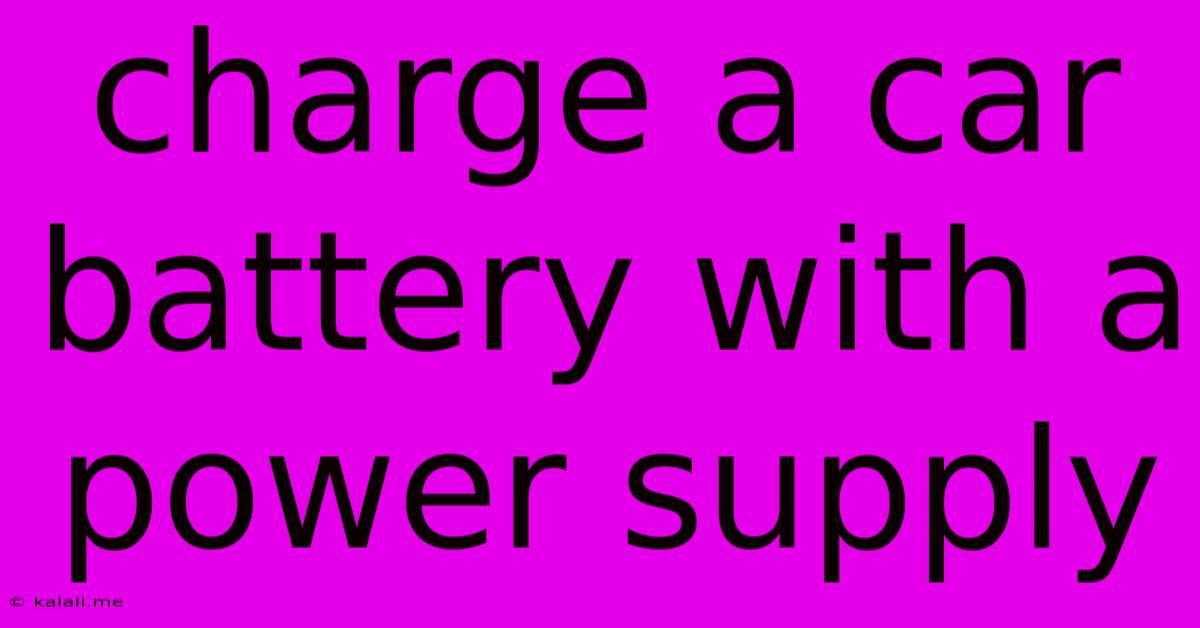Charge A Car Battery With A Power Supply
Kalali
Jun 07, 2025 · 4 min read

Table of Contents
Charging a Car Battery with a Power Supply: A Comprehensive Guide
Meta Description: Learn how to safely and effectively charge your car battery using a power supply. This guide covers essential safety precautions, choosing the right power supply, and the step-by-step charging process. Avoid costly mistakes and keep your car running smoothly.
Car batteries, vital components of any vehicle, eventually lose their charge. While a jump start might provide temporary power, a proper charge is necessary to restore its full capacity. While a dedicated battery charger is ideal, you can also charge a car battery with a power supply—provided you understand the process and take the necessary precautions. This guide will walk you through the safe and effective method of charging your car battery using a power supply.
Understanding the Basics: Voltage and Amperage
Before you begin, it's crucial to understand the key electrical parameters: voltage and amperage. A typical car battery operates at 12 volts (V). The amperage (A) refers to the rate of charge. Using too high an amperage can damage the battery, while too low an amperage will result in a very slow charge. Finding the right balance is essential.
Choosing the Right Power Supply
Not all power supplies are created equal. When selecting a power supply for charging your car battery, consider the following:
- Voltage: The power supply must be a 12V DC (Direct Current) power supply. Using an AC (Alternating Current) power supply or an incorrect voltage will severely damage your battery.
- Amperage: The amperage should be appropriately matched to your battery's capacity. A lower amperage will result in a slower charging time, but it's generally safer for the battery. A good starting point is to use an amperage that's around 10% of the battery's Amp-hour (Ah) rating. For example, a 60Ah battery could be charged with a 6-amp power supply. Never exceed the manufacturer's recommended charging rate.
- Protection Features: Look for a power supply with over-voltage and over-current protection. These safety features help prevent damage to the battery and the power supply itself.
Safety Precautions: Prioritizing Safety
Charging a car battery involves working with electricity, so safety is paramount:
- Wear Safety Glasses: Protect your eyes from potential sparks or acid splashes.
- Work in a Well-Ventilated Area: Car batteries emit gases during charging.
- Disconnect the Battery Terminals: Before connecting anything, always disconnect the negative (-) terminal first, followed by the positive (+) terminal. This prevents accidental short circuits.
- Use Insulated Tools: Use insulated pliers or wrenches to handle the battery terminals.
- Avoid Contact with Battery Acid: Battery acid is corrosive. If any spills, immediately neutralize it with baking soda and water.
- Do not smoke or have any open flames near the battery as this could cause the flammable hydrogen gas released by the battery to ignite.
Step-by-Step Charging Process
- Prepare the Power Supply: Ensure the power supply is turned off and unplugged.
- Connect the Power Supply: Securely connect the positive (+) lead of the power supply to the positive (+) terminal of the battery, and the negative (-) lead to the negative (-) terminal. Use alligator clips for a secure connection.
- Turn On the Power Supply: Slowly turn on the power supply and monitor the amperage. The amperage should be within the safe range you determined earlier.
- Monitor the Charging Process: Observe the battery and power supply for any unusual signs such as overheating or excessive sparking.
- Check the Battery Voltage: Periodically check the battery voltage using a multimeter. Once the voltage reaches the fully charged level (around 12.6-13.2V), disconnect the power supply. This usually takes several hours, depending on the battery's capacity and the amperage of the power supply.
- Reconnect the Battery Terminals: Reconnect the battery terminals in reverse order: positive (+) first, then negative (-).
Post-Charging Considerations
After charging, inspect the battery for any signs of damage. If you notice any bulging, leaks, or other abnormalities, replace the battery immediately. A properly charged battery should easily start your car. If it still fails to start, there may be other issues with your vehicle's electrical system.
By following these steps and precautions, you can safely charge your car battery using a power supply. Remember, always prioritize safety and consult your vehicle's manual for specific recommendations. If you're unsure about any aspect of this process, seek professional assistance from a qualified mechanic.
Latest Posts
Latest Posts
-
Whose Ear Did Peter Cut Off
Jun 07, 2025
-
How To Plant And Grow Acorns
Jun 07, 2025
-
Can You Paint Over Lead Based Paint
Jun 07, 2025
-
Should I Watch The Hobbit Before Lord Of The Rings
Jun 07, 2025
-
Any Way To Go Back To The Org Youtube
Jun 07, 2025
Related Post
Thank you for visiting our website which covers about Charge A Car Battery With A Power Supply . We hope the information provided has been useful to you. Feel free to contact us if you have any questions or need further assistance. See you next time and don't miss to bookmark.